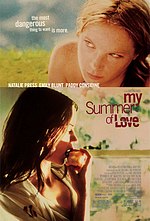

Knight at the Movies ARCHIVES

We are Women Hear Us Roar :
My Summer of Love, The Bette Davis and Joan Crawford DVD Collections
6-15-05 Knight at the Movies column
By Richard Knight, Jr.
One hot afternoon in the lush Cornwall countryside, Mona (Nathalie Press), a red-haired beauty who’s fallen
asleep by the roadside, is sited by Tamsin (Emily Blunt), a brunette Princess Charming who’s conveniently riding
by on horseback. The gorgeous Tamsin gently awakens Mona to see if anything’s amiss. Though Mona staggers
away from Tamsin, still groggy and making polite noises that everything’s okay, Tamsin has awakened a lot more
in Mona than either has realized. Here is the answer to another bored summer in her dreary little village for local
girl Mona and a breath of fresh air for the ennui of the cultured rich girl, Tamsin, who’s staying nearby for the
season.
Thus begins the enchanted fractured fairytale romance of My Summer of Love, the deliciously sensual new
film from writer-director Pawel Pawlikowski opening Friday at the Landmark Century. Fractured because this is a
tale of teenage love and lust which Pawlikowski captures it in all its wonderful/dreadful intensity. The look and
feel of the movie is the cinematic equivalent of the Broadway standard, “Lazy Afternoon,” so perfectly does it
capture the mood of that song’s evocative lyrics: “It’s a lazy afternoon/and the beetle bugs are zooming/and the
tulip trees are blooming/and there’s not another human in view/but us two.”
Mona’s an orphan with a charismatic older brother Phil (Paddy Considine), who has a long history riddled with
violence and petty crimes. Reformed, Phil’s turned the family’s pub, The Swan, into a haven for born-again
Christians like himself. Disgusted with what she perceives as a desecration to the one happy thing in her life and
her relationship with a married man abruptly ended, Mona soon finds herself taking a stroll toward the family
estate of a certain beautiful, rich brunette.
Stepping inside the gate we first hear the alternate dreamy/dissonant bell-like “La La” music that will serve as the
love theme for Mona and Tamsin. This is the first warning that this fairytale romance will not be all kisses and
roses. Mona ignores another cryptic warning from Mona’s father, who’s on his way out. When he finds out Mona’s
come to visit his daughter, he points toward the sound of the cello music wafting out of the upstairs windows,
adding a cryptic, “Good luck” for good measure before speeding away in his car.
Unsophisticated Mona isn’t ready to hear any warnings. She just knows that she’s poised for Something
Completely Different and a hot lesbian affair with the wealthy summer girl certainly suits the bill. Entering
Tamsin's room, Mona sits entranced listening to Tam play. “That was the The Swan by Saint-Saëns” Tamsin
comments after finishing the cello piece. “I live above the Swan pub,” Mona responds thus making plain the
cultural differences between the two characters. For her part, Tamsin quickly sizes up the country mouse vs. city
mouse situation and realizes that she has found an eager romantic protégé in Mona. Soon, the mysterious Tam is
introducing her friend to Edith Piaf, fine wine, and paying to have a motor installed in Mona’s motorbike.
Lots of handheld camera work and improvised scenes add to the growing emotional intimacy and confusion
between the young ladies. At last they spend the night together under Tamsin’s royal purple sheets – only to be
interrupted by Mona’s brother who has finally come looking for her. The supernova relationship of Tamsin the
fantasist and the more realistic Mona is bound to burn out but Pawlikowski defies expectations with some
interesting character twists and turns. Blunt and Press do exceptional work in their screen debuts and Considine is
equally impressive as Mona’s brother.
The late, great singer-songwriter Laura Nyro, who wrote very tellingly during her own teenage years, once said to
me, “I think teenagers are in touch with the primal forces of life and have a certain folk wisdom that’s only
available during those years.” That’s a perfect assessment of the brief, intense love between Mona and Tamsin in
My Summer of Love. An intensity to envy – or to be grateful to have missed.
+++++++++++++++++++++++++++++++++++++++++++++++++++++++++++++++
Joan Crawford died in 1977. Bette Davis in 1989. But here they are again, in their newly released, simultaneous
DVD boxed sets, The Joan Crawford Collection and The Bette Davis Collection, still battling it
out decades later. It’s very canny of Warner Bros. to be bringing out these two boxed sets (which were released
yesterday, June 14th) at the same time, with their matching art direction and containing five films from each star.
June, after all, is gay pride month, and who else other than middle aged gay men still carries the torch so highly for
these battling Hollywood titans?
The winner of the ongoing contest between the two feuding actresses who appeared onscreen only once (in the
enthralling, over the top thriller, What Ever Happened to Baby Jane?) is still a draw – but fans of the divas will be
running to the stores to grab these jam packed sets to decide for themselves. Davis will always have the edge,
acting-wise but Crawford certainly held her own and easily trumped Bette in the glamour department – evident
when viewing the films included here.
The Davis collection includes the previously released masterpieces The Letter and Now, Voyager and the new to
DVD melodrama supreme Dark Victory, silly but lush soap opera Mr. Skeffington, and the cheaply made but
riveting The Star. These films provide an almost perfect overview of Davis’s superstar years at Warner Bros.
while the little seen The Star from 1952 with Bette as the has been actress exclaiming to her Academy Award,
“C'mon Oscar, let’s you and me get drunk!” is the height of her post-WB years (All About Eve, aside).
Crawford is represented by repackaging of the previously released The Women and her Oscar winning
performance in film noir supreme Mildred Pierce along with the new to DVD dark romance of Humoresque and
Possessed and perhaps Crawford’s finest hard bitten dame in The Damned Don’t Cry. Though I love The Women,
it’s not a Crawford star vehicle and I’d have much preferred the inclusion of George Cukor’s masterful 1940
melodrama A Woman’s Face, which has yet to make it to DVD. It features Joan as the scarred ringleader of a
group of blackmailers and contains one of her best performances.
The re-releases on both sets contain the original extras (the best being the full length Anjelica Huston narrated
Crawford documentary on the Mildred Pierce disc) while new material includes short featurettes and full length
commentaries on each of the new films. All the movies are in glorious black and white, are sure to the basis for
gay screening parties for months to come and, hopefully, will inspire a younger generation of gay men to help keep
the Crawford-Davis rivalry alive. It’s just too much fun to let it die.
My Summer of Love, The Bette Davis and Joan Crawford DVD Collections
6-15-05 Knight at the Movies column
By Richard Knight, Jr.
One hot afternoon in the lush Cornwall countryside, Mona (Nathalie Press), a red-haired beauty who’s fallen
asleep by the roadside, is sited by Tamsin (Emily Blunt), a brunette Princess Charming who’s conveniently riding
by on horseback. The gorgeous Tamsin gently awakens Mona to see if anything’s amiss. Though Mona staggers
away from Tamsin, still groggy and making polite noises that everything’s okay, Tamsin has awakened a lot more
in Mona than either has realized. Here is the answer to another bored summer in her dreary little village for local
girl Mona and a breath of fresh air for the ennui of the cultured rich girl, Tamsin, who’s staying nearby for the
season.
Thus begins the enchanted fractured fairytale romance of My Summer of Love, the deliciously sensual new
film from writer-director Pawel Pawlikowski opening Friday at the Landmark Century. Fractured because this is a
tale of teenage love and lust which Pawlikowski captures it in all its wonderful/dreadful intensity. The look and
feel of the movie is the cinematic equivalent of the Broadway standard, “Lazy Afternoon,” so perfectly does it
capture the mood of that song’s evocative lyrics: “It’s a lazy afternoon/and the beetle bugs are zooming/and the
tulip trees are blooming/and there’s not another human in view/but us two.”
Mona’s an orphan with a charismatic older brother Phil (Paddy Considine), who has a long history riddled with
violence and petty crimes. Reformed, Phil’s turned the family’s pub, The Swan, into a haven for born-again
Christians like himself. Disgusted with what she perceives as a desecration to the one happy thing in her life and
her relationship with a married man abruptly ended, Mona soon finds herself taking a stroll toward the family
estate of a certain beautiful, rich brunette.
Stepping inside the gate we first hear the alternate dreamy/dissonant bell-like “La La” music that will serve as the
love theme for Mona and Tamsin. This is the first warning that this fairytale romance will not be all kisses and
roses. Mona ignores another cryptic warning from Mona’s father, who’s on his way out. When he finds out Mona’s
come to visit his daughter, he points toward the sound of the cello music wafting out of the upstairs windows,
adding a cryptic, “Good luck” for good measure before speeding away in his car.
Unsophisticated Mona isn’t ready to hear any warnings. She just knows that she’s poised for Something
Completely Different and a hot lesbian affair with the wealthy summer girl certainly suits the bill. Entering
Tamsin's room, Mona sits entranced listening to Tam play. “That was the The Swan by Saint-Saëns” Tamsin
comments after finishing the cello piece. “I live above the Swan pub,” Mona responds thus making plain the
cultural differences between the two characters. For her part, Tamsin quickly sizes up the country mouse vs. city
mouse situation and realizes that she has found an eager romantic protégé in Mona. Soon, the mysterious Tam is
introducing her friend to Edith Piaf, fine wine, and paying to have a motor installed in Mona’s motorbike.
Lots of handheld camera work and improvised scenes add to the growing emotional intimacy and confusion
between the young ladies. At last they spend the night together under Tamsin’s royal purple sheets – only to be
interrupted by Mona’s brother who has finally come looking for her. The supernova relationship of Tamsin the
fantasist and the more realistic Mona is bound to burn out but Pawlikowski defies expectations with some
interesting character twists and turns. Blunt and Press do exceptional work in their screen debuts and Considine is
equally impressive as Mona’s brother.
The late, great singer-songwriter Laura Nyro, who wrote very tellingly during her own teenage years, once said to
me, “I think teenagers are in touch with the primal forces of life and have a certain folk wisdom that’s only
available during those years.” That’s a perfect assessment of the brief, intense love between Mona and Tamsin in
My Summer of Love. An intensity to envy – or to be grateful to have missed.
+++++++++++++++++++++++++++++++++++++++++++++++++++++++++++++++
Joan Crawford died in 1977. Bette Davis in 1989. But here they are again, in their newly released, simultaneous
DVD boxed sets, The Joan Crawford Collection and The Bette Davis Collection, still battling it
out decades later. It’s very canny of Warner Bros. to be bringing out these two boxed sets (which were released
yesterday, June 14th) at the same time, with their matching art direction and containing five films from each star.
June, after all, is gay pride month, and who else other than middle aged gay men still carries the torch so highly for
these battling Hollywood titans?
The winner of the ongoing contest between the two feuding actresses who appeared onscreen only once (in the
enthralling, over the top thriller, What Ever Happened to Baby Jane?) is still a draw – but fans of the divas will be
running to the stores to grab these jam packed sets to decide for themselves. Davis will always have the edge,
acting-wise but Crawford certainly held her own and easily trumped Bette in the glamour department – evident
when viewing the films included here.
The Davis collection includes the previously released masterpieces The Letter and Now, Voyager and the new to
DVD melodrama supreme Dark Victory, silly but lush soap opera Mr. Skeffington, and the cheaply made but
riveting The Star. These films provide an almost perfect overview of Davis’s superstar years at Warner Bros.
while the little seen The Star from 1952 with Bette as the has been actress exclaiming to her Academy Award,
“C'mon Oscar, let’s you and me get drunk!” is the height of her post-WB years (All About Eve, aside).
Crawford is represented by repackaging of the previously released The Women and her Oscar winning
performance in film noir supreme Mildred Pierce along with the new to DVD dark romance of Humoresque and
Possessed and perhaps Crawford’s finest hard bitten dame in The Damned Don’t Cry. Though I love The Women,
it’s not a Crawford star vehicle and I’d have much preferred the inclusion of George Cukor’s masterful 1940
melodrama A Woman’s Face, which has yet to make it to DVD. It features Joan as the scarred ringleader of a
group of blackmailers and contains one of her best performances.
The re-releases on both sets contain the original extras (the best being the full length Anjelica Huston narrated
Crawford documentary on the Mildred Pierce disc) while new material includes short featurettes and full length
commentaries on each of the new films. All the movies are in glorious black and white, are sure to the basis for
gay screening parties for months to come and, hopefully, will inspire a younger generation of gay men to help keep
the Crawford-Davis rivalry alive. It’s just too much fun to let it die.
Coy Toys, two titans continuing to battle it out


